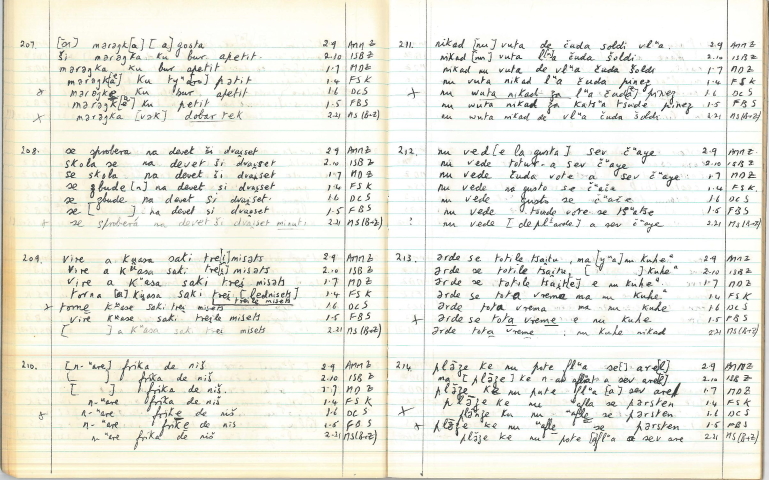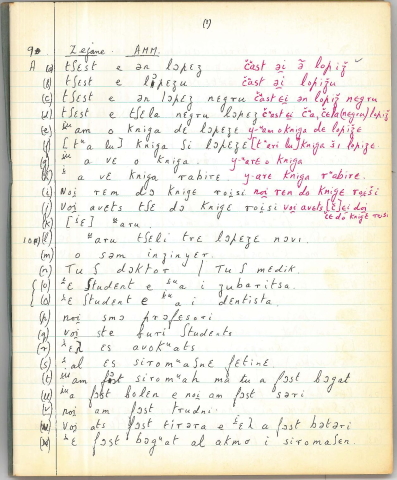So-called ‘Istro-Romanian’ is a Romance language. That is to say that it is historically descended from the Latin of the Roman Empire, and it is therefore a member of the same linguistic family as Portuguese, Spanish, French, or Italian. As the term ‘Istro-Romanian’ suggests, the language is most closely related to the one surviving major Romance language of Eastern Europe, namely Romanian. In fact it is one of four major branches of what linguists call ‘Daco-Romance’, which refers to the surviving Romance (Latin-based) languages of south-eastern Europe, continuing the Latin assumed to have been spoken in the Roman province of Dacia. The three ‘sisters’ of Istro-Romanian within the Daco-Romance family are:
- Romanian (Republic of Romania, Republic of Moldova, and nearby areas); some 25 million speakers
- Aromanian (also known as Macedo-Romanian): widespread in the Balkan area, particularly in Albania, in central and northern Greece and in south-western Macedonia, with anywhere between two or three hundred thousand and five hundred thousand
- Megleno-Romanian, with: barely 5000 speakers, settled in villages in the Pella and Kilkis prefectures in northern Grece, and in the Republic of North Macedonia on the other side of the frontier, in the region of Huma (Umă)

It is perhaps indicative of the limited cultural and political prestige historically enjoyed by Istro-Romanian that the term ‘Istro-Romanian’ needed to be invented by linguists (in recognition of the fact that it is a form of Romanian spoken in Istria), and that there is no real indigenous word for the language in all its varieties. While the Croatian word ‘istrorumunjski’ may now be used by native speakers as a cover-term for the language, these speakers usually refer to the ‘northern’ variety spoken in Žejane and the 'southern' variety spoken in and around Šušnjevica, as žejånski and vlåški, respectively. Both of these names are actually Croatian in origin, and indeed the term vlåški comes from vlah (in English Vlach) an ancient designation in the Balkan region for Romanian-speakers.
We don’t know for sure when Istro-Romanian broke away from the ancestor of modern Romanian, but the separation may go back as much as a thousand years. The place of origin of the language, and the question whether it branched off from varieties spoken in Romania (in certain respects it resembles modern Romanian dialects of western Transylvania), or from other varieties spoken in the Balkans, or whether it represents a dialect mixture, are still controversial (see Sârbu and Frățilă 1998:13-18).
Throughout nearly all of its history, ‘Istro-Romanian’ has been a purely oral language, with no native written tradition until the twentieth century. This means that we have very little knowledge of its history and structure before the last century, when linguists began to take a detailed scientific interest in it.
The first mention of the Latinity of this language and its resemblance with what we now call ‘Romanian’ was made by the Venetian Carmelite preacher and chronicler Ireneo della Croce in 1698, who also indicates the name by which its speakers referred to themselves as a group, ‘Rumeri’. The language has left behind some tantalizing glimpses of its earlier history and geographical extension in placenames in the language such as Floričići, Pulići, Jerbulišče (in the orthography used by Pușcariu 1926: 34) in Istria, or Fintira on the island of Krk.
All modern speakers still resident in Croatia are natively bilingual in Istro-Romanian and the South Slavonic language Croatian, and this bilingualism seems ancient. An effect of this is that the language is intriguingly different from Romanian and other Romance languages, and in some respects looks distinctly Slavonic. This is certainly not just a matter of ‘borrowing’ items of vocabulary from Croatian. For example, the word order of Istro-Romanian has a very Slavonic appearance, with adjectives commonly appearing before nouns (something relatively unusual in Romance and especially in Romanian), and pronouns appearing in positions in the sentence that are perfectly normal for Croatian, but quite disconcerting for anyone used to the general patterns found in Romance languages. Istro-Romanian, uniquely among Romance languages, has also developed, following a typically Slavonic model, an extensive system of ‘aspect’ marking in the verb: put very simply, each form of the verb distinguishes whether the action or state the verb expresses is viewed from ‘inside’ as ongoing, or from ‘outside’ as completed. Istro-Romanian has invented a wide range of ways of marking this distinction (and also some other kinds of aspect distinction), including sometimes keeping a native word for one meaning, and borrowing a Croatian word for the other. The aspect system of Istro-Romanian is, by the way, a subject in which Tony Hurren was particularly interested.
While in the past hundred years linguists have learned a lot about the structure of this fascinating language, there is still much to learn and many intriguing phenomena remain to be properly understood. Every scrap of evidence gathered is precious, not just to those who take a scientific interest in the language, but as part of the history of the Istro-Romanian community at large. Linguists all know that the most precious and authoritative asset for the study of any disappearing language is its native speakers. In the case of Istro-Romanian these are now very few in number and relatively advanced in years. Unsurprisingly, the UNESCO Atlas of the World’s Languages in Danger (www.unesco.org/languages-atlas) describes Istro-Romanian as a ‘severely endangered’ language.
Although the language is often described as ‘dying’, it is by no means dead. Its importance and well-being are supported from various quarters. The Ministry of Culture of the Republic of Croatia included Istro-Romanian on its list of ‘protected intangible cultural heritages’ in 2007. The community is named in various ways by outsiders, such as the use of older but ill-defined term ‘Vlachs’, or of the more recent, scientific, term, ‘Istro-Romanians’ (Kovačec 2013: 82), the latter being increasingly common even in official documents. Speakers from Šušnjevica seem undecided on the choice between these ethnic group names, while those from Žejane show a clear preference for ‘Žejanci’, derived from the name of their village. This may be why, although ‘Vlachs’ are recognized as a national minority in the Croatian constitution of 2010, in the 2011 census only 29 individuals declared themselves to be ‘Vlachs’.
There was and still is a desire to see the languages taught to younger generations. As an official initiative, in 1921 the local intellectual Andrei Glavina opened an Istro-Romanian school in Šušnjevica, with apparently over 400 pupils. Even though teaching was in Italian and Romanian, the schoolchildren’s mother tongue was recognized and integrated into the teaching process. Glavina would have liked to see official encouragement to open the same type of school in Žejane (see Glavina’s letters at the beginning of the twentieth century to his teacher A. Viciu in Blaj, Transylvania), but this did not happen. Alas, the school created by Glavina in Šušnjevica closed in 1925 when Glavina died, but after nearly a century, as an initiative of the community and with the support of volunteers, Istro-Romanian has again been taught in children's language playgroups both in Šušnjevica (where the playgroup Puljići has been running since 2011, led by Viviana Brkarić with the assistance of Marina Mikuluš), and in Žejane (where the Žejančići playgroup, led by Adrijana Gabriš, ran from 2013-2019). Very importantly, there are active cultural associations concerned with the Istro-Romanian language in Croatia, in the United States, and online. See especially the activities of the project for preservation of the Vlaški and Žejanski language Očuvęj vlåška ši žejånska limba (started in New York in 2005), whose website is at www.vlaski-zejanski.com.
These associations have also been active in seeking to standardize the written language (the Andrei Glavina association, founded in 1994, has been printing books in the language and a magazine since 1996). However, Istro-Romanian has no long-established written tradition, and it has usually been written down using various forms of phonetic transcription. Unfortunately, but understandably, they have not all used the same system. Since nowadays there is an internationally recognized system of phonetic transcription, the International Phonetic Alphabet (where you can also hear the sounds being pronounced), we have done our best here to give IPA equivalents for the transcriptions used by other scholars.

[ę] = [æ]/[ɛ] near-open near-front unrounded vowel or open-mid near-front unrounded vowel
[å] = [ɒ] open back rounded vowel
[â] = [ɘ] close-mid central unrounded vowel
Consonants
[t''] = [c] voiceless palatal plosive
[d''] = [ɟ] voiced palatal plosive
[ţ] = [t͡s] voiceless alveolar affricate
[ḑ] = [d͡z] voiced alveolar affricate
[č] = [t͡ʃ] voiceless palato-alveolar sibilant affricate
[ǧ] = [d͡ʒ] voiced palato-alveolar sibilant affricate
[š] = [ʃ] voiceless post-alveolar fricative
[ž] = [ʒ] voiced post-alveolar fricative
[γ] = [ɣ] voiced velar fricative
[ľ] = [ʎ] palatal lateral approximant
[ń] = [ɲ] palatal nasal